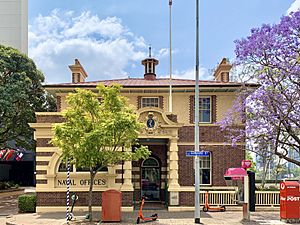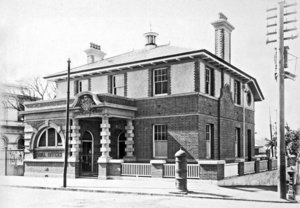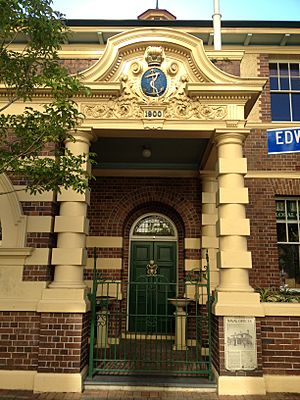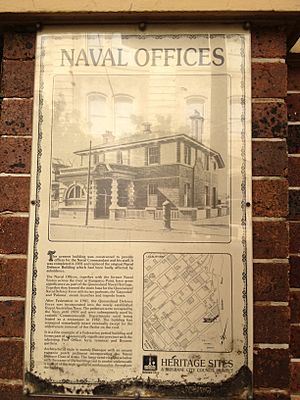Naval Offices, Brisbane facts for kids
Quick facts for kids Naval Offices |
|
|---|---|

Naval Offices, 2019
|
|
| Location | 3 Edward Street, Brisbane City, City of Brisbane, Queensland, Australia |
| Design period | 1900–1914 (early 20th century) |
| Built | 1900–1901 |
| Built for | Queensland Marine Defence Force |
| Architect | Department of Public Works |
| Architectural style(s) | Arts & Crafts |
| Official name: Naval Offices (former), Brisbane, Naval Offices (former) | |
| Type | state heritage (built) |
| Designated | 21 March 2013 |
| Reference no. | 600101 |
| Significant period | 1901–1970s |
| Builders | J Mason |
| Lua error in Module:Location_map at line 420: attempt to index field 'wikibase' (a nil value). | |
The Naval Offices is a historic building in Brisbane City, Queensland, Australia. It was built between 1900 and 1901 by J Mason and designed by the Queensland Department of Public Works. This building was the first one made specifically to be a headquarters for naval forces in Queensland. It was first used by the Queensland Marine Defence Force (QMDF) and later by the Royal Australian Navy (RAN). Today, it is listed on the Queensland Heritage Register because of its important history and unique design.
Contents
The Naval Offices building is made of brick and is located at 3 Edward Street in Brisbane. It was built from 1900 to 1901. This building was very special because it was the first one designed just for Queensland's naval forces.
It was originally built for the Queensland Marine Defence Force (QMDF). Soon after, it was used by the Australian Commonwealth Navy (ACN). In 1911, the building became property of the Commonwealth Government and was then used by the Royal Australian Navy (RAN) for many years.
The Naval Offices are located near the Brisbane River. This area was important for shipping and government offices related to the port. Before this building, the QMDF used an older Port Office building from 1862.
The QMDF was created in 1885. This happened because people in Queensland were worried about their coastal towns being attacked by warships from other countries, especially Russia. To protect Queensland, experts suggested using small naval ships, building a fort at Lytton, and having a strong land force. They also needed a Naval Brigade (volunteer sailors) and a Torpedo Corps.
To help defend Queensland, several naval vessels were ordered.
- The first ship was the "Mosquito," a small torpedo boat that arrived in 1884.
- The main ships were two gunboats, "Gayundah" and "Paluma," which arrived in 1885. These ships were important for training the QMDF sailors.
- Other vessels like the "Midge" and auxiliary ships also joined the force.
Captain Henry Townley Wright became the Senior Naval Officer in 1885. He commanded the "Gayundah" and helped train the first permanent members of the QMDF.
Building the New Headquarters
By 1896, the old Port Office building used by the QMDF was in bad shape. It had been damaged by floods in 1893, and the roof was leaking. So, in 1899, money was set aside to build new offices.
In May 1900, Captain William Rooke Creswell, Queensland's new Naval Commandant, decided the new offices would be built at the corner of Edward and Alice Streets. The old caretaker's cottage there was removed.
Plans for the new Naval Offices were approved in September 1900. The Department of Public Works was known for designing excellent buildings. The construction was finished by June 1901 by James Mason. The building had dark-brown bricks with cement details and a galvanised iron roof.
The building was designed to be a naval headquarters. It had offices for senior naval officers and their staff. There was also a strong room for the Staff Paymaster to keep important documents and money safe.
- The ground floor had an entrance from Edward Street. It led to a public area and offices for clerks and the Paymaster.
- The Commandant's office and the Naval Corps Officer's office were also on the ground floor.
- A separate "Brigade Entrance" allowed access to the rear verandah and a staircase.
- The first floor was a large open space called the Orderly (Administrative) Room. It might have been divided into sleeping quarters or more offices later.
From Queensland to Commonwealth Control
Even though the building started for the QMDF, the first people to use it were part of the new Commonwealth Navy. When Australia became a federation on 1 January 1901, the defence forces of the different colonies were transferred to the new Federal Government.
Queensland's naval forces, including ships like the "Gayundah" and "Paluma," became part of the Australian Commonwealth Naval Force (ACNF) in 1901. Captain Creswell continued to lead the Queensland naval group.
Captain Creswell strongly believed Australia should have its own independent navy. In 1909, it was agreed to form an Australian fleet. On 10 July 1911, King George V gave the name "Royal Australian Navy" to the ACN.
Although the Commonwealth took control of Queensland's naval forces in 1901, the Naval Offices building itself was not officially transferred to Commonwealth ownership until 1911.
Changes Over Time
The Naval Offices building had several changes while the Commonwealth owned it.
- In 1933, a rear verandah was added to the first floor. The first floor was also changed into a home for the Senior Naval Officer.
- More offices and toilets were added in late 1939.
- During World War II, Brisbane became a very important centre for the Allied navies. More space was needed, so in 1944, a two-storey timber extension was added, and the verandahs were enclosed to create more offices.
By 1977, the Naval Offices building was empty. Its naval functions had moved to another base. The building was then leased out for many years. In 1982, it became "Muddies Seafood Restaurant."
After the restaurant closed in 1989, the building was renovated in the early 1990s. During this time, some of the later additions, like the 1944 office extensions, were removed. The original rear verandah was rebuilt. The inside was also changed, with some walls put back on the ground floor and the first floor opened up into a large space.
Today, the building is owned by the Queensland State Government. It has been used by different businesses, like a florist and architectural firms.
The former Naval Offices is a two-storey brick building. It stands on the corner of Edward and Alice streets, looking out over the Brisbane River. The building takes up most of its land, with a small yard behind it.
Building Style and Features
The building is made of strong bricks with timber floors and roof. The outside walls are made of deep red bricks with light grey lines between them. The top floor has a stucco finish (a type of plaster) with brick corners and window frames.
The windows are large and rectangular, with wooden frames. There is also a unique round window on the upper level on the Alice Street side. The roof has wide eaves (overhangs) and is covered with metal sheets. You can also see a central metal vent on the roof and two tall chimneys on the sides.
The building is known for its "Arts and Crafts" style. This means it has:
- Beautiful brickwork and stucco.
- Tall, decorative chimneys.
- Fancy eaves with brackets (supports).
- A special semi-circular window.
- A grand entrance porch with columns and a curved top that has a sculpted naval coat of arms (a symbol of the navy).
Inside the Building
When you enter the building through the decorative iron gate, the floor is made of colourful tiles. There are two sets of double timber doors with glass panels that lead inside.
The ground floor has a central hallway with two main rooms on each side. The floors are timber, and the walls are plaster. The rooms have fireplaces, and one room has a strong room with a heavy iron door. The doors inside are made of varnished timber. The glass on the main entrance doors says "Commonwealth of Australia Naval Office."
A large plaster royal coat of arms is above the entrance doors. There's also a timber staircase leading to the first floor.
The first floor has carpeted timber floors and plaster walls. It's currently divided by timber walls that don't reach the ceiling. There are four fireplaces on this floor, but they don't work anymore. A kitchen is located in a room at the back.
Location and Views
The Naval Offices is a smaller building surrounded by larger historic buildings on Edward Street. These include the former Port Office and the Port Office Hotel. It is also next to the entrance of the City Botanic Gardens.
The building can be seen from the Brisbane River. You can even see the former Naval Stores at Kangaroo Point across the river from here.
Why is it a Heritage Site?
The former Naval Offices was added to the Queensland Heritage Register on 21 March 2013 for several reasons:
- Important History: It shows the history of Queensland's naval defence. It was built for the Queensland Marine Defence Force and then used by the Australian Commonwealth Navy and Royal Australian Navy until the 1970s. It highlights how important naval defence was during the time of Australia's Federation.
- Unique Building: It is the only naval headquarters building ever built by the Queensland government, making it very rare and special.
- Great Design: It's a wonderful example of the high-quality buildings designed by the Queensland Department of Public Works. It has a smart layout, is built with strong, local materials, and looks very dignified. Its inside layout, with separate entrances for the public and naval staff, shows its original use as a naval office.
- Beautiful Look: The building is important for its beautiful "Arts and Crafts" design. This includes its unique brickwork, decorative chimneys, and the fancy entrance with its sculpted naval coat of arms. It adds a lot to the historic streetscape of Edward Street.
- Naval Connection: It has a strong and long-lasting connection to the naval forces of Queensland and Australia. It served as a key location for naval operations for many decades.




